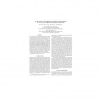Free Online Productivity Tools
i2Speak
i2Symbol
i2OCR
iTex2Img
iWeb2Print
iWeb2Shot
i2Type
iPdf2Split
iPdf2Merge
i2Bopomofo
i2Arabic
i2Style
i2Image
i2PDF
iLatex2Rtf
Sci2ools
ISBI
2009
IEEE
2009
IEEE
Quantitative Comparison of Spot Detection Methods in Live-Cell Fluorescence Microscopy Imaging
In live-cell fluorescence microscopy imaging, quantitative analysis of biological image data generally involves the detection of many subresolution objects, appearing as diffraction-limited spots. Due to acquisition limitations, the signal-to-noise ratio (SNR) can be extremely low, making automated spot detection a very challenging task. In this paper, we quantitatively evaluate the performance of the most frequently used supervised and unsupervised detection methods for this purpose. Experiments on synthetic images of three different types, for which ground truth was available, as well as on real image data sets acquired for two different biological studies, for which we obtained expert manual annotations for comparison, revealed that for very low SNRs (≈2), the supervised (machine learning) methods perform best overall, closely followed by the detectors based on the so-called h-dome transform from mathematical morphology and the multiscale variance-stabilizing transform, which do...
Image Data | ISBI 2009 | Live-cell fluorescence Microscopy | Medical Imaging | Unsupervised Detection Methods |
| Added | 19 May 2010 |
| Updated | 19 May 2010 |
| Type | Conference |
| Year | 2009 |
| Where | ISBI |
| Authors | Ihor Smal, Marco Loog, Wiro J. Niessen, Erik H. W. Meijering |
Comments (0)

